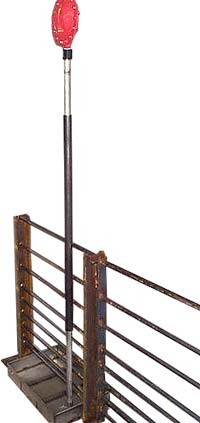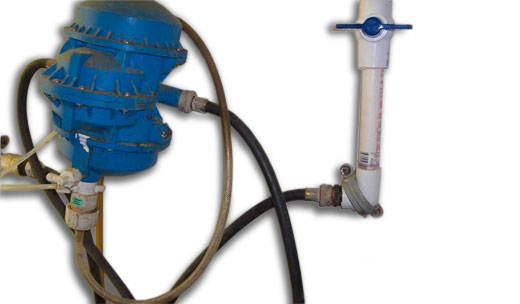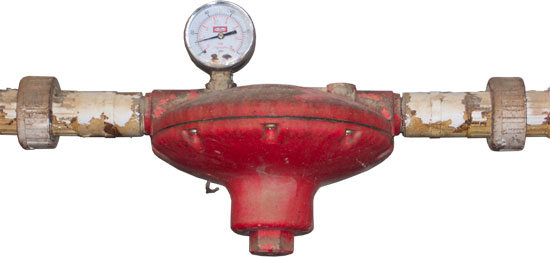 |
| Typical ‘pan’ drinker with diaphragm flow controller |
Water Line Restrictions
As grow-finish facilities have grown in size, water supply issues have generally not been a consideration. Water lines in swine facilities that connect to drinking devices are almost always 19 mm ID (inside diameter) in North America. This is true whether there are 200 pigs drinking from devices attached to the supply line or 1600 pigs drinking.
The Midwest Plan Service (1997) recommends that water supply lines be sized with a velocity of 1.2 m per second. If we apply this sizing to drinking water lines, we come up with the following capacity:
where R is the radius (in mm) of the piping.
For 19 mm ID piping, the equation becomes:
Thus, water delivery plumbing has the following flow rate capacities:
19 mm ID 20 liter/min
25 mm ID 35 liter/min
If we use a drinking rate of 1000 ml/minute (Li and Gonyou, 2000), we can see that every pig drinking at the same time on a water delivery line must be provided with approximately 1 liter pr minute. This means that the typical 19 mm water line in a production grow-finish facility has the capacity for no more than 22 drinking devices. If more devices are installed the possibility exists that one or more devices will have a limited flow at some point when a pig drinks.
One common restriction to water availability is improper attachment of water medicators to drinking lines. While many medicators have rated capacities of up to 27 liters per minute, it is not uncommon to attach them to drinking water supply lines with 13 mm washing machine hose. This type of attachment means the limit to drinking water supply is the flow limit of the attachment hose. In some instances, restrictions in the attachment plumbing are as severe as 9.5 mm, meaning flow is restricted to 5.3 liters per minute.

Water medicator (26 liter per minute capacity) connected to 19 mm water line with 13 mm washing machine hoses.
In North America, almost no production site uses header tanks in their water delivery system. Systems rely on high pressure (250 – 500 kPa) to deliver water to the facility, either from a well, surface water storage unit or municipal source. An often overlooked restriction in these high pressure water delivery systems is the installation of a pressure regulator. Manufacturers of wet/dry feeders often recommend pressure reductions to 70 kPa for the water supply lines in facilities and other drinker devices are often installed with line pressures of 140 kPa. The intent of these lower pressures is to reduce the effort required by the pig to activate the delivery devices, making wastage less likely.
However, changes in pressure change flow. The formula to compute the impact of a change in pressure on flow is:
where P1 is the new pressure and P2 is the original pressure.
Thus, if the supply pressure to the facility is 280 kPa and the pressure reducer is set to 140 kPa, the resulting flow rate is 71% of what it was at 280 kPa. At 70 kPa versus a supply pressure of 280 kPa, the flow rate is 50%. Conversely, if you double the pressure (go from 170 kPa to 280 kPa), the flow increases only 41%, assuming there aren’t other limits to flow in the delivery system.

In-line pressure reducer. Set to reduce pressure to 70 kPa (10 psi) from an incoming pressure of 280 kPa (40 psi).
Producers are increasingly recording daily drinking water disappearance as an indicator of animal health and well being. However, water meters are often the restriction in water flow in the water systems. While 19 mm piping is commonly used through out the facility, many of the water meters installed in production facilities in North America have 16 mm orifices, meaning the water meter is the restriction point in water flow.
A final restriction often encountered in water delivery systems in swine units is water filters. These are often installed in delivery lines to deal with sediment issues associated with the on-site well, etc. In some instances, the location of the filters makes them very difficult to routinely flush or clean, while in others, a routine of regular maintenance is not planned for or followed.




